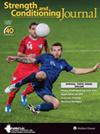Anthropometric, Physiological, and Physical Profile of Elite Snowboarding Athletes
IF 3
4区 医学
Q2 SPORT SCIENCES
引用次数: 0
Abstract
ABSTRACT A successful snowboarding performance is a multifactorial accomplishment resulting from a complex interaction of the major fitness components. This review aimed to examine the anthropometric, physiological, and physical profiles of elite snowboarding athletes. A database search was performed in the China National Knowledge Infrastructure, PubMed, SPORT Discus, and Web of Science. The findings indicate that (a) elite speed-based and skill-based athletes generally had low body fat percentages. The height and body mass of men speed-based athletes are slightly larger than those of skill-based athletes. (b) The energy system predominantly engaged in is anaerobic metabolism. Muscle oxidative metabolism could help to promote recovery in the repeated high-intensity runs. (c) Top levels of lower-body strength, especially the eccentric force production and explosive concentric power production of athletes, have a determinant role in rapid riding and turning, jump amplitude, trick difficulty, and successful landing. The take-off velocity of skill-based snowboarding and the starting and turning speed of speed-based snowboarding also have a major effect on success in competitions. Further research is warranted to investigate the anthropometry, the relative energy system contributions from aerobic and anaerobic metabolism, and the effect of physical training on performance while considering the possible differentiated effects of different snowboarding disciplines.优秀单板滑雪运动员的人体测量、生理和身体特征
摘要成功的单板滑雪成绩是由主要健身成分的复杂相互作用产生的多因素成就。这篇综述旨在检验优秀单板滑雪运动员的人体测量、生理和身体特征。在中国国家知识基础设施、PubMed、SPORT Discus和Web of Science上进行了数据库搜索。研究结果表明:(a)以速度为基础和以技术为基础的精英运动员的体脂百分比通常较低。男子速度型运动员的身高和体重略大于技术型运动员。(b) 主要参与的能量系统是厌氧代谢。肌肉氧化代谢有助于在重复的高强度跑步中促进恢复。(c) 下半身力量的顶级水平,尤其是运动员的偏心力和爆发力,对快速骑行和转身、跳跃幅度、技巧难度和成功落地都有决定性作用。基于技术的单板滑雪的起飞速度和基于速度的单板雪的起步和转弯速度也对比赛的成功有重要影响。需要进一步研究人体测量、有氧和无氧代谢对能量系统的相对贡献,以及体育训练对成绩的影响,同时考虑不同单板滑雪学科可能产生的差异效应。
本文章由计算机程序翻译,如有差异,请以英文原文为准。
求助全文
约1分钟内获得全文
求助全文
来源期刊

Strength and Conditioning Journal
社会科学-运动科学
CiteScore
4.70
自引率
8.00%
发文量
49
审稿时长
6-12 weeks
期刊介绍:
Strength and Conditioning Journal is the professional journal for strength coaches, personal trainers, physical therapists, athletic trainers, and other health professionals working in the strength and conditioning field. The journal’s mission is to publish articles that report both the practical applications of research findings and the knowledge gained by experienced professionals.
 求助内容:
求助内容: 应助结果提醒方式:
应助结果提醒方式:


